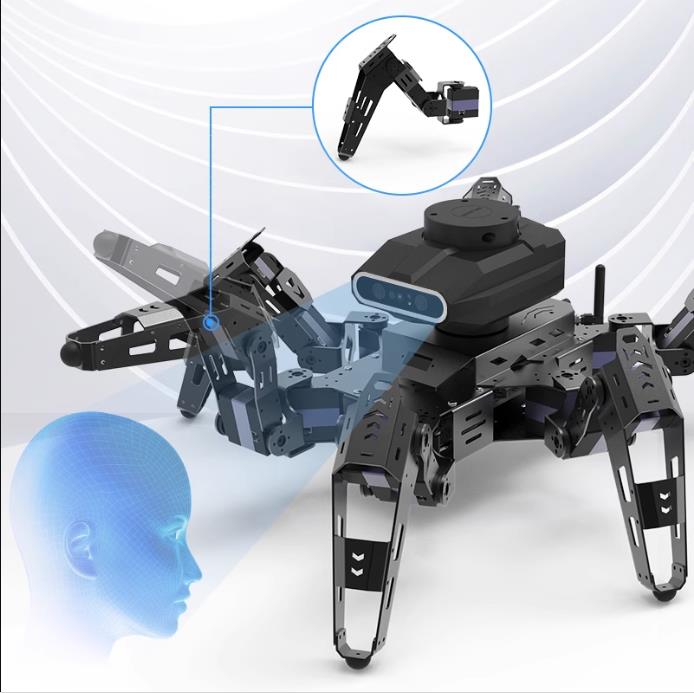1. The changes brought by ROS to the XR bionic hexapod spider robot
Jetson Nano is a small artificial intelligence (AI) computing motherboard launched by NVIDIA. Its biggest highlight is that it is equipped with a relatively high-end GPU in the embedded field, with 128 NVIDIA CUDA cores and based on the NVIDIA Maxwell architecture. In addition, it is equipped with a quad-core ARM Cortex-A57 processor and 4GB of LPDDR4 memory, providing the robot with powerful computing and storage capabilities.
The introduction of ROS has brought unprecedented convenience to the software development of the XR bionic hexapod spider robot. Through the modular design of ROS, developers can independently develop and test each functional module of the robot (such as perception, decision-making, control, etc.), greatly improving development efficiency. At the same time, the communication mechanism of ROS enables convenient data exchange and collaborative work between modules, providing a strong guarantee for the robot's complex task execution.
In terms of perception, ROS supports a variety of sensor interfaces, allowing the XR bionic hexapod spider robot to easily access various sensor devices, such as cameras, lidar, etc., to achieve comprehensive perception of the environment. In terms of decision-making, ROS provides a rich algorithm library and toolkit, which provides strong support for the robot's autonomous navigation, obstacle avoidance, etc. In terms of control, ROS realizes precise control of each actuator of the robot through a unified control interface, ensuring the stability and reliability of the robot.
2. Technical details of the integration of XR bionic hexapod spider robot and ROS
Hexapod walking mechanism: The XR bionic hexapod spider robot uses 18 XR-S270 35KG bi-weekly serial bus servos as the hexapod walking mechanism motion joints, which gives it excellent terrain adaptability. Whether it is in rugged mountains, muddy swamps or narrow gaps, it can shuttle freely.
Intelligent perception system: Combined with the sensor interface of ROS, the XR bionic hexapod spider robot can obtain environmental information in real time, and process and analyze it through algorithms such as deep learning. This enables the robot to more accurately identify targets, judge obstacles and plan paths.
Autonomous navigation and obstacle avoidance: The algorithm library and toolkit provided by ROS provide strong support for the autonomous navigation and obstacle avoidance of the XR bionic hexapod spider robot. Realize 2D laser radar mapping, navigation, obstacle avoidance and other functions. Through the depth camera, not only can all AI vision functions of the RGB camera be realized, but also deep image data processing, RTAB three-dimensional visual mapping and other deep vision functions can be realized, so that the robot can perform autonomous navigation and obstacle avoidance, global relocation, autonomous positioning and other functions in complex environments.
Built-in IMU attitude sensor: Through the attitude data obtained by the IMU, the collective attitude can be monitored in real time by closed-loop control. So no matter how the plane shakes, it can keep the fuselage in a balanced state.
Control system: The ROS control system provides precise control capabilities for the XR bionic hexapod spider robot. Through a unified control interface, the robot can achieve precise control of each actuator to ensure the stability and accuracy of the movement.
Rich machine vision function gameplay: The head can be dotted RGB camera or depth camera, and the integrated machine vision library can be used to freely develop AI vision functions. The default AI vision functions of the hexapod include face recognition, edge detection, Aruco augmented reality, gesture recognition, KCF target tracking, QRcode recognition, color recognition, radar tracking, group control formation, etc.
3. Advantages and application scenarios of ROSXR bionic six-legged spider robot
The integration of XR bionic six-legged spider robot and ROS not only brings technical convenience, but also shows great potential in application scenarios. First of all, the six-legged walking mechanism enables the robot to have excellent terrain adaptability and can walk freely in various complex environments. The introduction of ROS further enhances the robot's autonomy and intelligence, enabling it to better adapt to the needs of various complex tasks.
For example, in rescue scenarios, the XR bionic six-legged spider robot can use its excellent terrain adaptability and autonomous navigation capabilities to quickly reach the disaster area and provide important information support for rescuers. At the same time, its powerful perception and decision-making capabilities can also help rescuers more accurately judge the disaster situation and formulate more reasonable rescue plans.
In the field of exploration, the XR bionic six-legged spider robot can also play its unique advantages. Its six-legged walking mechanism can easily cope with various rugged terrains, and the introduction of ROS provides it with powerful data processing and decision-making support capabilities. This enables the robot to better cope with the challenges of unknown environments and provide explorers with more comprehensive and accurate geographic information and environmental data.
3. Looking to the future
Looking to the future, with the deep integration of the Jetson nano XR phage bionic six-legged spider robot and ROS technology, we seem to see a future world full of infinite possibilities. In this world, robots are no longer cold machines, but intelligent life forms. They can not only shuttle freely in extreme environments, but also solve complex problems autonomously under the guidance of humans, and even surpass human capabilities in some areas. In the future, perhaps they will play an important role in exploring the universe, protecting the earth, and serving mankind, becoming a bridge connecting people and technology, reality and the future. Let us look forward to the arrival of this day together and witness the brilliant sparks of the collision of technology and wisdom.

